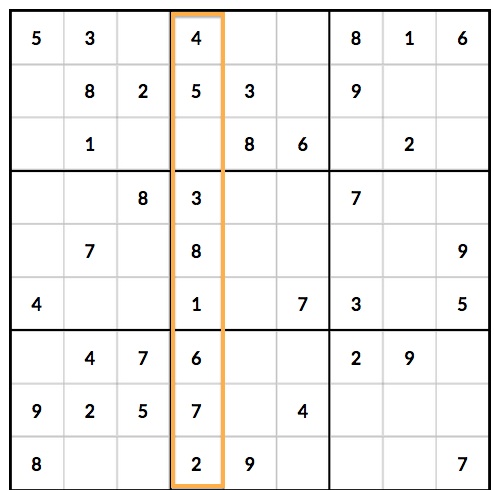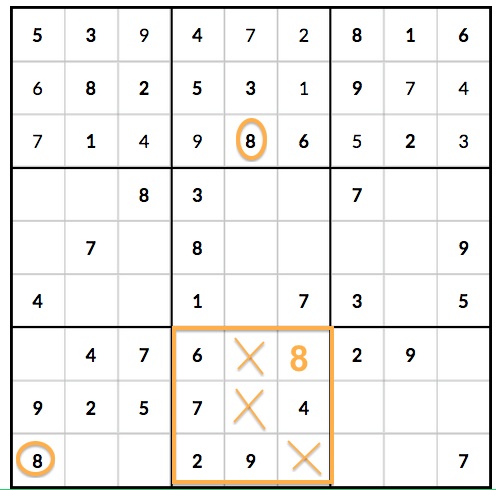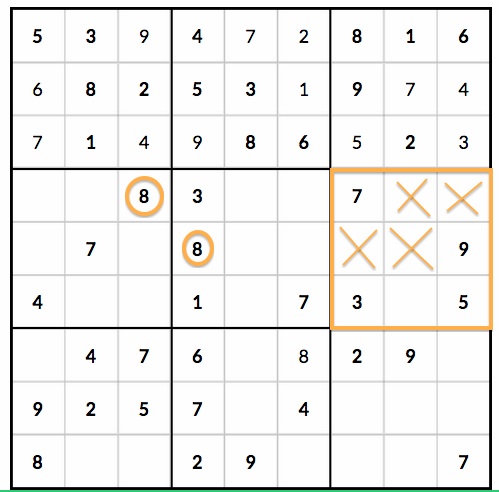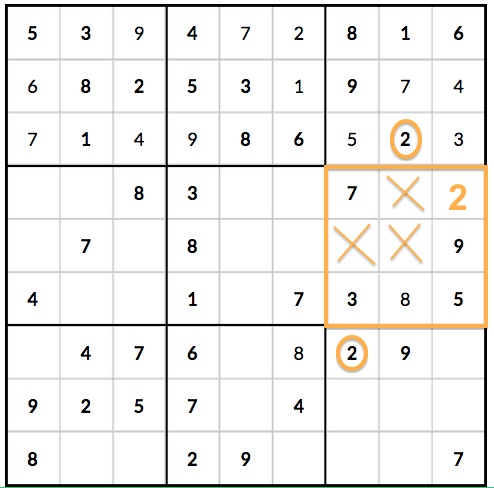3 Sudoku Mistakes that Beginning Players Make

Don’t get frustrated. Sudoku can be a fun and rewarding pastime for many hours of enjoyment. It’s important to learn how to get past the most common Sudoku beginner mistakes so you can move forward confidently and keep playing Sudoku for many years to come.
Here are a few of the most common Sudoku mistakes for beginners:
Missing “low hanging fruit”
Sudoku is a game of recognizing opportunities. Players need to constantly scan the grid and spot chances to place a number into an empty space. Unfortunately, beginner Sudoku players often do not know how to recognize even the easiest opportunities that are right in front of them.

For example, in the grid shown here, there is a vertical column (the 4th column from left, outlined in orange) that has 8 out of 9 numbers already placed. We know that there is only one number left to place here. This is an easy opportunity for a beginning Sudoku player to place a number on the grid – but many first-time Sudoku players might not realize it and might spend time gazing at other areas of the grid instead. So Sudoku players need to know: start by looking for “low-hanging fruit” like this. Look for rows, columns and squares that already have a lot of numbers in place. This will make it easier for you to place numbers and solve the puzzle.
Ignoring Squares
Sudoku is a game of placing numbers 1-9 in empty spaces within the same row, column or square – however, many beginning Sudoku players make the mistake of only focusing on rows (horizontal) or columns (vertical). Maybe it’s easier for Sudoku beginners to visualize and count through the numbers 1-9 when they are placed in a row or column?
Whatever the reason, many Sudoku beginners are making a mistake, because they’re not spending enough time looking at squares. Squares (there are 9 of them on the grid, and each contains 9 spaces) are a great place to look for opportunities to place numbers, because each square is made up of other rows and columns. You can get lots of information about which numbers can be eliminated or placed within a square just by looking to the nearby rows and columns that make up that square.

For example, in this grid shown here, there is a square (bottom center, outlined in orange) that has four empty spaces. We know from counting up the existing numbers in the square that the missing numbers are 1, 3, 5 and 8. If we look to the bottom row on the left, and in the central column above, we see two number 8s (circled in orange) which eliminate three of the spaces from containing the number 8 (X’d out in orange). This shows us that the number 8 must go in the upper right corner of the square (marked in orange).
Ignoring Open Areas of the Grid
Sudoku is a game of momentum, so it’s natural to want to focus on the parts of the grid where you’re already having success with placing numbers. By all means, don’t take your foot off the gas pedal – keep placing numbers if you know where they go.

But one other mistake that many Sudoku beginners make is to focus too much on the parts of the grid where they’re having success, and forget about the parts of the grid that are largely blank. Just because a row or column or square has a lot of empty spaces doesn’t mean you can’t make progress there.
For example, in this grid, there is a square to the right (outlined in orange) that seems like a low-potential place to work on – it has five empty spaces. But if we look more closely we can see some opportunities.
We know that the missing numbers are 1, 2, 4, 6 and 8. We can see two number 8s in the top two rows (circled in orange) which eliminate four of the 5 spaces (marked with Xs in orange). This means that the number 8 must go in the lower center space of the square (currently left blank).

Once the number 8 is placed, we can see another opportunity within this same square. As shown in this grid, the remaining numbers to place 1, 2, 4 and 6.
We can see number 2s (circled in orange) in the left and center columns, which means that the number 2 must go in the upper right square (marked in orange).
This example shows how it’s possible to make some progress in a part of the grid that seemed to be less than promising. Don’t rely too much on the “usual suspects” parts of the grid – don’t be afraid to look in a totally different direction.